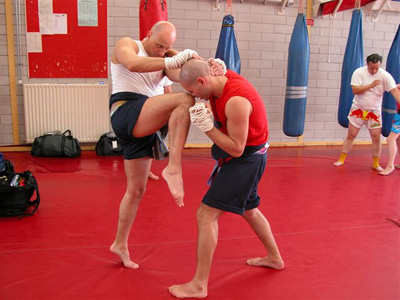Muay Thai training methods
by Marco De Cesaris
Since forever in the East, the transmission
to posterity of the martial knowledge of a specific school or combat
style utilized the codifying system involving sequences of movements
that crystallized a situation of confrontation with one or more adversaries.
These sequences, which they call Katas in Japan, Taos in China, and
Poomses in Korea, contain a kind of genetic code of the style that they
represent, and their study, if done under the guidance of an expert
who knows the “key readings” of the sequences, allows us
to open the doors of the method and conceive combat according to a specific
martial school from the past. Among the traditional fighting Arts, Muay
Thai Boran is not an exception to what we have just said, but, due to
the reduced interest in martial combat in its home country, the re-discovery
of the forms containing the DNA of the empty-hands, Siamese martial
style had to await the meticulous work of reconstruction of the scholars
from the Office of the Cultural Commission of the Thai Ministry of Education.
In more recent times, the search for the origins and the “layered”
codification done in the following epochs has been passed on to the
Association of Traditional Martial Arts of Thailand (AITMA) and to its
representative on the European continent, the International Muay Boran
Academy (IMBA).
In reality, the common practice in the sphere of sportive Thai Boxing
followed the path of Western Boxing: the training called “shadow
boxing” replaced the practice of the codified sets very well,
developing essential physical attributes in the athletes preparing for
the ring, such as looseness and speed of movements, the physical memory
of series and strike combinations, and cardiovascular stamina.
All of that helps the preparation of professional athletes, and without
a doubt that custom can also be imitated by the practitioners orientated
to the traditional study and to self-defense; but for a true martial
practice, the codified forms in times in which the discipline was a
genuine Art of war, utilized in times of peace in confrontations to
the death and without rules, represent an irreplaceable instrument of
knowledge.
Despite the fact that the majority of people consider Muay Thai a discipline
based exclusively on physical power, achieved through exhausting training
sessions, the rediscovery of the traditional forms allows one to see
the Siamese art from a very different perspective: the practitioners
of the past (the majority soldiers and therefore warriors) had to fight
under all kinds of conditions, often on the move for long periods and,
in any case, they couldn’t follow a rigid and constant training
regimen such as those that are used today by the Siamese boxers. For
this did the necessity of exploiting techniques that made them “poisonous
like a snake” arose, that is, capable of being detrimental to
the adversary with select actions capable of being applied in times
of scarce athletic training.
The different necessities of the sportive fighters have caused most
to forget these possibilities, but through the study of the traditional
sequences, we can appropriate exceptional cultural knowledge of martial
technique.
In Muay Boran, contrary to what is believed, there are codified forms
for different and very specific uses: in the initial phase of learning,
the so-called short forms of training are utilized, which are distinguished
by three groups according to the following scheme:
- Ways of training
a. Study of individual weapon from a static position
b. Study of individual weapon with movements
c. Application of the techniques in pairs
Sometimes the shortest training forms are also executed according to
the method of the “one breath exercises,” given that the
whole strike sequence was executed with only one breath. In fact, according
to the theories of the old masters, the secret of the effectiveness
of these combinations was in the speed with which the individual movements
were linked and, in consequence, the speed of execution of the sequence
didn’t allow one to enact more than one complete breath, just
as it would in fact occur during real combat. The result of all of that
was the duration of these forms, indispensable for its rapid application
during combat.
While studying the short forms, the practitioner, according to the dictates
of the traditional theory, had to be initiated to the practice of the
basic forms of the Muay Boran system, the famous sequences of defense
and counter-attack executed in pairs, known as Mai Khru or Mae Mai Muay
Thai: studying the Mai Khru with a partner and under the guidance of
the Master, the student was initiated into the essential concepts of
combat, for example, the placement of the sensitive points of the human
body, the choice of timing of attack or defense, the various fighting
distances, and the natural weapons to deflect or stop the adversary’s
strikes.
Once the study of the Mae Mai was completed, the Khru Muay would introduce
the student to the more subtle and sophisticated accessory techniques,
the Mai Kred or Look Mai Muay Thai, which led the practitioner to higher
levels of technical domination.
The last two steps, in order of difficulty, can be identified in the
Combined Forms and in the Long Forms; the first are the true “secret”
of the most traditional Muay Boran, and are characterized by the complexity
of the offensive and defensive actions and are combined with numerous
Mae Mai that are not a part of the 15 basic ones—but equally important—reaching
(and is some styles surpassing) the notable number of 108. Finally,
the long forms are different according to the distinct regional styles
and are subdivided in accord with the employment of the weapons utilized
in the form, for example, the elbow or knee, or mixed long forms.
